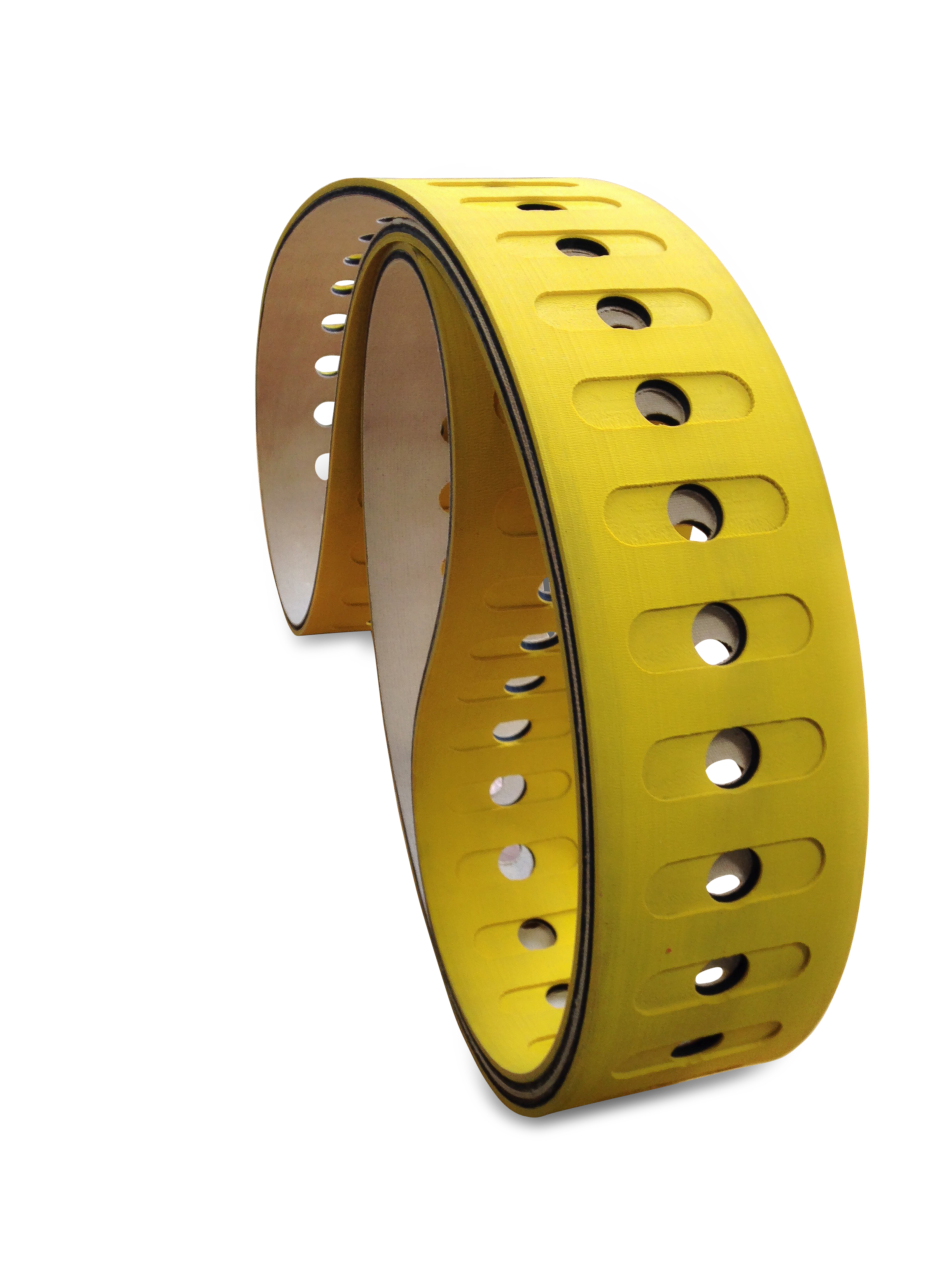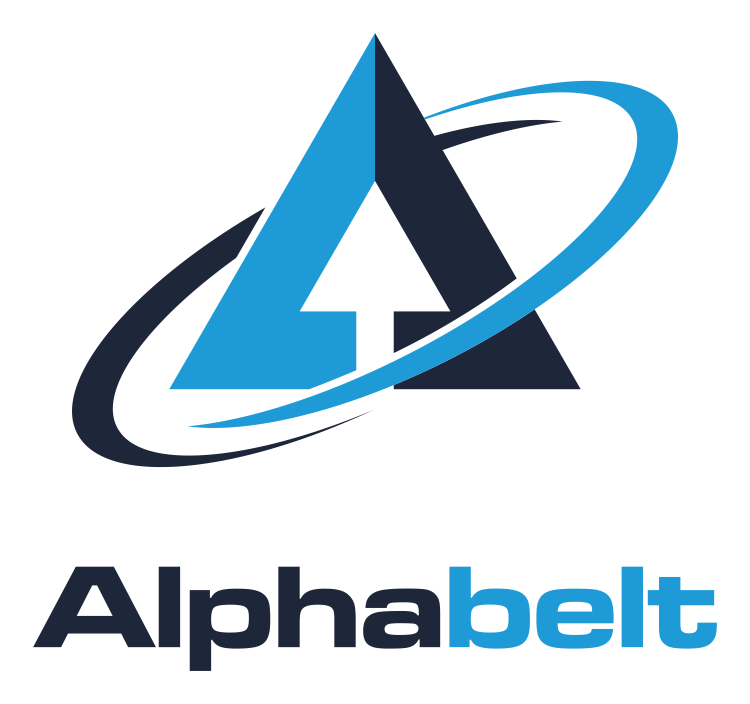Vacuum belts - Five frequently asked questions briefly answered
What are vacuum belts needed for? How are they manufactured? And what information is important when placing an order?

Vacuum belts –
customized for maximum precision
VVacuum belts are available in a wide variety of designs: Perforated, with pockets or without, with a wide variety of coatings, without tension cords at all or only with tension cord-free zones, as wide timing belts, etc....
But what are vacuum belts actually needed for? How are they manufactured? And what information is important when placing an order? We have compiled the most frequently asked questions and brief answers on the subject of vacuum belts for you here:
1. What is a vacuum belt and how does it work?
Simply put, a vacuum belt is a perforated conveyor belt. The material to be transported is carried along in a force-fit manner. A vacuum channel is usually milled on the tooth side, with which an applied vacuum is distributed to the perforations. The vacuum is transferred from the tooth side to the back of the belt by means of the perforations. This sucks the material to be conveyed onto the conveyor belt and increases the frictional connection.
In most cases, a vacuum belt has a special coating that further improves the adhesion of the conveyed material. Indentations on the surface of the belt back, so-called pockets, create an additional suction effect when pressed against the conveyed material during operation.
2. Where are vacuum belts used?
Vacuum belts are mainly used for:
- the transport of light unit loads such as envelopes, chip cards, hygiene articles, or coffee pads;
- the vertical haul-off of packaging films, mainly on form, fill and seal machines;
- the transport of objects that are not dimensionally stable, such as films and printed sheets.
Vacuum belts are very often used in the packaging industry. But they are also used in the printing industry, logistics and other industries where light goods are to be transported at high speeds or where precise feeding is required.
3. What are the variants of vacuum belts?
Vacuum belts are probably at least as diverse as the different goods and the fields for which they are used. Of course, standard designs are available for specific applications. However, if a belt is to be tailored exactly to all requirements, a custom-designed belt is optimal. There are numerous options to choose from for an individualized vacuum belt:
Shape of the base belt:
Vacuum belts can be designed as a pure conveyor belt, a timing belt or a poly-V belt.
Material of the base belt:
PU and neoprene have proven themselves as the material for the base belt.
Geometry of the base belt:
The basic belt is available in various lengths, widths, thicknesses and with different tooth shapes and tooth pitches, depending on the design.
Tension cords:
Tension cords made of steel and Kevlar are possible, in special cases also made of stainless steel. Vacuum belts can also be made completely or partially free of tension cords on request. Tension cord free zones are necessary if the tension cords obstruct punching or if severed, frayed tension cord strands would damage sensitive goods to be transported.
Vacuum channel:
A vacuum channel can be milled on the tooth side, which rests on a vacuum rail during operation. The vacuum is distributed to the perforations by means of the channel. The width of the channel can be freely selected.
Winding noses:
Winding noses are grooves in the tooth base which increase the flexibility of timing belts. However, in vacuum applications, pressure losses can also occur via the winding noses. If the vacuum losses must be kept as low as possible, the winding nose is omitted. Also, FDA-compliant timing belts usually do not have a winding nose for hygienic reasons.
Tooth-side coating:
To protect against wear, the tooth side and, if necessary, also the vacuum channel can be coated with a particularly abrasion-resistant layer of polyamide fabric (PAZ).
Back-side coating:
Among other things, the coating of the belt back is decisive for the coefficient of friction, the hardness, the grip properties and the resistance of the belt, for example to wear, high or low temperatures, solvents, cleaning agents and chemicals, wetness, greases and oils, etc. Numerous coating materials with a wide range of properties are available to choose from, depending on the requirements and operating conditions.
Perforation geometry:
The diameters of the holes can be freely selected. The hole spacing is usually determined in relation to the tooth pitch. Multi-row perforations are also possible.
Pocket geometry:
The diameters of the holes can be freely selected. The hole spacing is usually determined in relation to the tooth pitch. Multi-row perforations are also possible.
FDA Design:
Special materials and refinement techniques are available for applications in the food sector. Vacuum belts of our FoodGuard line are of course available with a declaration of conformity according to FDA and EU.
4. How are vacuum timing belts manufactured?
The manufacture of vacuum timing belts involves several different processing steps and is therefore comparatively complex.
Manufacture of the base belt:
The basic belt for a vacuum timing belt can basically be manufactured in three different ways: from yard goods, from a sleeve or as a flex timing belt. If no particularly high tensile forces occur during operation, the simplest method is to manufacture from yard goods. Here, the desired length is cut off a coil and the ends are joined either with a belt connector or by a special welding process. If the belt has to withstand higher forces, it is manufactured endless so that there is no potential weak point. Common lengths and pitches are available as prefabricated sleeves from which any desired width can be cut. If a sleeve is not available, a flex timing belt of the desired length can also be manufactured.
Apply the coating:
The coating material must be permanently bonded to the base belt using a suitable process. Depending on the material combination, the connection can be made by welding, bonding, vulcanizing, spraying or, in special cases, by liquid application (squeegeeing).
Milling processing:
Both the tooth-side channel for the vacuum and the vacuum pockets are produced by milling. CNC-controlled tools are usually used to ensure a precise pocket geometry produced individually according to the customer's requirements.
Perforating:
The holes that transfer the vacuum from the tooth side to the back of the belt can be punched or cut by water jet. Although waterjet cutting is more elaborate, it has the advantage that the tension cords do not fray at the cut edges. Residues of frayed strands could later cause damage to sensitive transport goods during operation.
Grinding to specification:
If tight tolerances must be maintained in the width or height of the belt, the corresponding side is ground to size.
5. WWhat information do I need for an inquiry or order of a vacuum belt?
In order to process your inquiry or order for a vacuum timing belt as well as possible, we need some information from you:
- Tooth form (e.g. T5, T10, ...)
- Length, width, total thickness of the belt (with tolerances if necessary)
- Material
- tension cord (yes, no, zones only, material of tension cord?)
- Coating (material and thickness)
- Vacuum channel (width and depth)
- Wear protection PAZ (yes or no, also for vacuum channel?)
- Perforation (diameter and pitch)
- Pocket geometry (shape, pattern, depth)
- Required certificates (e.g. FDA, EU)
And what if I don't have all the information at hand?
No need to worry. Just tell us as much as possible about the plant, the operating conditions, the shape and nature of the goods to be transported, and any special requirements (e.g. FDA conformity). We will be happy to advise you on which options are available for your application and which vacuum timing belt is best suited for it. We will also be glad to support you in the development of a new vacuum belt. We look forward to your message!
Contact

